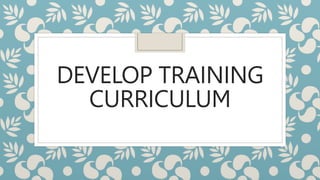
DEVELOP-TRAINING-CURRICULUM.pptx
- 2. COC 2 - DTC ◦ This unit covers the knowledge, skills and attitude required to develop, modify/customize training curriculum. It includes establishing training requirements, identifying the learner, developing, modifying, customizing and finalizing training curriculum. Learning Outcomes: 1. Establish Training Need Requirements 2. Identify the Learner Profile 3. Develop Course Design 4. Develop Training Curriculum Modules 5. Finalize Training Curriculum
- 3. Curriculum Development Process 3 Types (Susan Sharpe) 7 types (Mary G. Alvion) 11 Types (Leslie Owen Wilson. Ed. D.) Explicit Hidden Absent/Null Recommended Written Taught Supported Assessed Learned Overt, explicit or written curriculum Societal curriculum for social curricula Hidden or covert curriculum Null curriculum Phantom curriculum Concomitant curriculum Rhetorical curriculum Curriculum in use Received curriculum Internal curriculum Electronic curriculum
- 4. Explicit Curriculum ◦ Also known as overt or official curriculum, entails the lesson plans to follow ◦ This type of curriculum is what appears in documents and teachers' plans. ◦ Intentionally presented as the basic material of schooling ◦ Formal/ stated mandated curricula that contain explicit steps and procedures to follow for proper implementation/Stated and intended outcomes
- 5. Hidden Curriculum ◦ Practices and procedures resulting from decisions made when implementing the explicit curriculum ◦ Unintended outcomes that occurs as the explicit curriculum is implemented ◦ Success of hidden curriculum is attributed to practices, procedures, rules and structures (classroom, teacher’s exercise of authority, rules governing the relationship between teachers and students ◦ Teacher is the center of attention
- 6. Absent/Null Curriculum ◦ What is not taught ◦ Curricular aspects excluded( either intentionally or unintentionally from classroom instruction that are appropriate to the explicit curriculum
- 7. OVERT, EXPLICIT, OR WRITTEN CURRICULUM ◦ Is simply that which is written as part of formal instruction of schooling experiences.
- 8. SOCIETAL CURRICULUM (OR SOCIAL CURRICULA) ◦ This type of curricula can now be expanded to include the powerful effects of social media (YouTube; Facebook; Twitter; Pinterest, etc) and how it actively helps create new perspectives, and can help shape both individual and public opinion.
- 9. THE HIDDEN OR COVERT CURRICULUM ◦ That which is implied by the very structure and nature of schools, much of what revolves around daily or established routines. ◦ refers to the kinds of learnings children derive from the very nature and organizational design of the public school, as well as from the behaviors and attitudes of teachers and administrators....
- 10. THE NULL CURRICULUM ◦ That which we do not teach, thus giving students the message that these elements are not important in their educational experiences or in our society
- 11. PHANTOM Curriculum ◦ The messages prevalent in and through exposure to any type of media. These components and messages play a major part in the enculturation of students into the predominant meta‐culture, or in acculturating students into narrower or generational subcultures.
- 12. CONCOMITANT CURRICULUM ◦ What is taught, or emphasized at home, or those experiences that are part of a family’s experiences, or related experiences sanctioned by the family. (This type of curriculum may be received at church, in the context of religious expression, lessons on values, ethics or morals, molded behaviors, or social experiences based on the family’s preferences.)
- 13. RHETORICAL CURRICULUM ◦ Elements from the rhetorical curriculum are comprised from ideas offered by policymakers, school officials, administrators, or politicians. This curriculum may also come from those professionals involved in concept formation and content changes; or from those educational initiatives resulting from decisions based on national and state reports, public speeches, or from texts critiquing outdated educational practices.
- 14. CURRICULUM‐IN‐USE ◦ The curriculum‐in‐use is the actual curriculum that delivered and presented by each teacher.
- 15. RECEIVED CURRICULUM ◦ Those things that students actually take out of classrooms; those concepts and content that are truly learned and remembered.
- 16. THE INTERNAL CURRICULUM ◦ Processes, content, knowledge combined with the experiences and realities of the learner to create new knowledge. While educators should be aware of this curriculum, they have little control over the internal curriculum since it is unique to each student. Educators can explore this curricula by using instructional assessments like “exit slips,” reflective exercises, or debriefing discussions to see what students really remember from a lesson. It is often very enlightening and surprising to find out what has meaning for learners and what does not.
- 17. THE ELECTRONIC CURRICULUM ◦ Those lessons learned through searching the Internet for information, or through using e‐forms of communication. (Wilson, 2004) This type of curriculum may be either formal or informal, and inherent lessons may be overt or covert, good or bad, correct or incorrect depending on ones’ views. Students who use the Internet on a regular basis, both for recreational purposes (as in blogs, wikis, chatrooms, list serves, through instant messenger, on‐line conversations, or through personal e‐mails and sites like Twitter, Facebook, or You tube) and for personal online research and information gathering are bombarded with all types of media and messages.
- 18. Requirement of the Course Attend all meetings called for by the training institution; Perform all the activities included in the LMS; Submit a complete output of the required materials for the course such as: a. Work Plan b. Curriculum Development Requirements: Template: Name of the Institution: Mission/Vision/Goals and Objectives (institution/office) Organizational Culture and Values Value Statement Stakeholders Training Aims and Requirements Individual Learning Style Training Methodology Training Supplies, Materials and Equipment Training Facility Trainers’ Qualification Assessment Method
- 19. c. Profile of potential Trainees (attach link of the form and excel responses) d. Prepare CBC Framework ( CLM – Contextual Learning Matrix – 1UC ) e. Develop Course Design f. Develop Module of Instruction (MOI using TESDA-OP CO-01-F11 (Rev.No.00-03/08/17) g. Prepare validation Instrument h. Prepare Validation Report i. Checklist of Evidences for Institutional Assessment j. Prepare a Written Report k. Final Curriculum l. Recommendation letter to authorized person on the dev. curriculum m. Relevant references